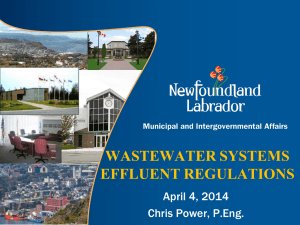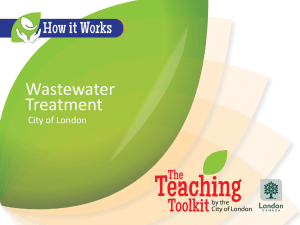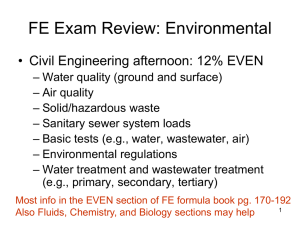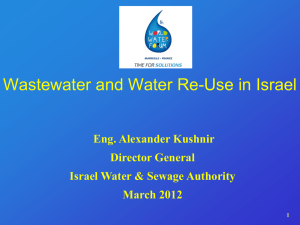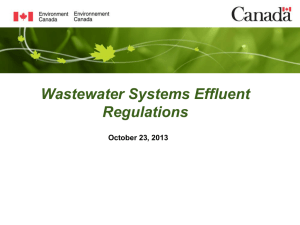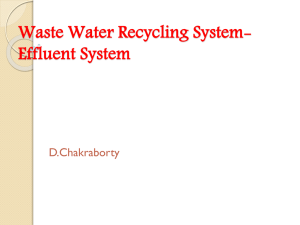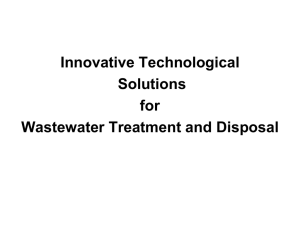Andres De Vleeschawer - Environment Canada Regulations
advertisement
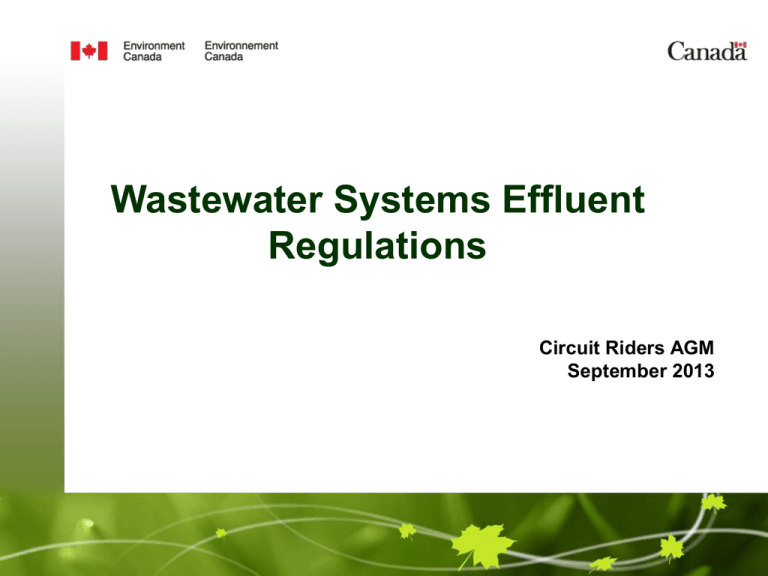
Wastewater Systems Effluent Regulations Circuit Riders AGM September 2013 Outline • Introduction • Status of WSER Implementation in First Nations • • • • • • Communities What if I missed the deadline to report? Reporting Annually vs Quarterly Transitional Authorizations WSER and other requirements Reporting wastewater spills List of Environment Canada contacts Page 2 Introduction • Wastewater Systems Effluent Regulations (WSER) in force as of June 2012 – Require effluent to achieve secondary wastewater treatment – Establish risk-based compliance timelines • Apply to systems located in First Nations communities discharging over 100 m3/day to surface water • Environment Canada regional staff are helping First Nations report on the WSER • May 15, 2013 was the deadline for first report – ID Report for all, and first Effluent Monitoring Report if subject to quarterly reporting Page 3 Status of WSER Implementation in First Nations Communities • Estimate there are 220 First Nations subject to the • WSER across Canada Currently have Identification Reports for 126 (57%) – AB-1, BC-21, MB-53, NL-2, NS-7, ON-14, PE-1, QC-20 • Only about ½ of these ID Reports have been approved • Pressing need to: – Monitor effluent, keep records and report as per the WSER – Finalize and approve ID Reports (due May 15, 2013) – Complete Effluent Monitoring Report if subject to quarterly reporting (due May 15, 2013) – we think there are only a few • If planning to apply for a Transitional Authorization by June 14, 2014, you need to already have begun Page 4 monitoring I’ve missed the deadline to report… now what? • Owners/operators of wastewater systems subject to the WSER need to submit and approve their ID Reports ASAP – Must be done electronically – Paper copies are available if electronic submission is not technically feasible (e.g. no internet access) • If the owner/operator is required to report quarterly, and they haven’t already done so, then they need to write a letter to the Authorization Officer (i.e. James Arnott) to explain how they will address the situation and ensure that the next monitoring report is submitted on time • If an owner/operator of a wastewater system is subject to annual reporting, they have until February 14, 2014 to submit this report Page 5 Reporting Annually vs Quarterly • Most intermittently discharging systems or continuous • systems with HRT ≥ 5 days are annual reporters – this will be the case for most systems located in FN communities The following are quarterly reporters: – Continuous discharging systems (e.g. mechanical) – Continuous discharging systems with an HRT ≥ 5 days (i.e. lagoons) and an average daily effluent volume >2500 m3 – Intermittently discharging systems >17500 m3 We anticipate only a few systems located in FN communities would be quarterly reporters Page 6 Transitional Authorizations (TAs) • If a wastewater system is not designed to achieve secondary level • • • • treatment, the owner/operator needs to apply to the Authorization Officer for a TA – CBOD and/or TSS > 25mg/L need a TA TA allows the system to operate and sets the timeline to achieve secondary treatment Without a TA, depositing effluent that exceeds 25/25 is not authorized and would be a contravention of subsection 36(3) of the Fisheries Act TA sets site-specific limits, allowing the system to operate We expect that several systems located in First Nations communities need to apply for a TA Page 7 I need a TA… now what? • If the owner/operator of a wastewater system needs to • • • upgrade their system to secondary and they haven’t started monitoring, then they need to start ASAP Currently out of compliance with the Regulations since not already collecting data Jeopardizing an opportunity to allow for time under the WSER to bring the wastewater system into compliance An electronic reporting module for TAs will be available by the end of 2013 in Environment Canada’s Electronic Regulatory Reporting Information System (ERRIS) Page 8 Transitional Authorization • May be applied for, beginning January 1, 2013, if the average CBOD and/or SS exceeded 25 mg/L in the effluent deposited from the final discharge point during the specified period(s) (Section 24) • Required information (Section 25) includes: – Effluent quality and quantity and description of the water where effluent is deposited – Number of points allocated to the final discharge point (Schedule 2) and, if used, to a combined sewer overflow point (Schedule 3) – Plan for the modifications to be made to the system to achieve secondary treatment, or equivalent – Plan for the modifications to be made to reduce combined sewer overflows (if Schedule 3 is used) • Submitted electronically to the authorization officer by June 30, 2014 Page 9 Transitional Authorization (continued) • Schedule 2 – Points allocated to the final discharge point are based on: ▪ Annual average daily volume ▪ CBOD, SS, TRC and NH3 ▪ Description of water where effluent is deposited via final discharge point • Schedule 3 (Optional) – Points allocated to a CSO point based on: ▪ Estimated ADWF* at CSO point / Estimated ADWF at final discharge point ▪ # of overflows in a year ▪ Description of water where effluent is deposited via overflow point – *ADWF: average dry weather flow Page 10 Transitional Authorization (continued) • Transitional authorization period (Subsection 26(2)) will begin on January 1, 2015 and will end on: – December 31, 2020, if points ≥ 70 based on Schedule 2 – December 31, 2030, if points ≥ 50 to < 70 based on Schedule 2 – December 31, 2040 ▪ ▪ If points < 50 based on Schedule 2; or If points ≥ 50 based on Schedule 2 and total points based on Schedule 3 ≥ total points on Schedule 2 • Transitional authorization may expire early (Section 33) if the effluent was not acutely lethal and met the CBOD and SS averages of 25 mg/L during specified periods Page 11 Transitional Authorization (continued) • The transitional authorization indicates the site-specific authorized concentrations of the prescribed deleterious substances for the duration of transitional authorization (Section 30) • The holder of a transitional authorization must: – Meet the site-specific authorized concentrations (Section 28) – Satisfy compliance obligations (Section 29) ▪ Similar to those for systems meeting the standards (e.g. monitor effluent quantity and quality) ▪ Upgrade the system according to the plan for modification and the implementation schedule submitted ▪ Submit progress reports on the steps taken to implement the plan – Submit a revised plan if changes are made to it (Section 27) • Upon expiry, effluent quality standards for CBOD and SS must be met Page 12 WSER and other requirements • WSER specify the following deleterious substances and the concentrations that can be discharged not exceed the corresponding conditions: – Average CBOD (25mg/L), average Suspended Solids (25mg/L), total residual chlorine average (0.02mg/L), un-ionized ammonia (maximum 1.25mg/L) • In addition, local conditions may require effluent treatment to go beyond WSER (e.g. which address coliform or other contaminants) – Coliforms and some other contaminants not regulated under the WSER, as they were considered to be a site-specific issue – On-Reserve Source Water Protection Plans may address these • For example, if body of water receiving wastewater effluent is sensitive or used for swimming, fishing or drinking, then these local conditions may require effluent treatment to go beyond the WSER • Up to the owner/operators of these systems to know which to follow • The WSER supersedes the 1976 Guidelines for Effluent Quality and Wastewater Treatment at Federal Establishments • Page 13 Wastewater Spills • The Fisheries Act requires owners/operators of • • wastewater systems to report spills Contact numbers in each province are found on the following page Note that 1-800 numbers are usually only accessible if calling from within the respective province Page 14 Reporting Wastewater Spills Province Office Telephone Ontario Spills Action Centre, Ontario Ministry of the Environment 416-325-3000 or 1-800-268-6060 Quebec Environmental Protection Operations Directorate, Quebec, Environment Canada 514-283-2333 or 1-866-283-2333 Nova Scotia, New Brunswick and PEI Maritimes Regional Office, Canadian Cost Guard, Fisheries and Oceans Canada 902-426-6030 or 1-800-565-1633 Manitoba Manitoba Department of Conservation 204-944-4888 British Columbia British Columbia Provincial Emergency Program, Ministry of Public Safety and Solicitor General 1-800-663-3456 Saskatchewan Saskatchewan Ministry of Environment 1-800-667-7525 Alberta Alberta Ministry of Environment 780-422-4505 or 1-800-222-6514 Newfoundland and Labrador Newfoundland and Labrador Regional Office, Canadian Coast Guard, Fisheries and Oceans Canada 709-772-2083 or 1-800-563-9089 Yukon Yukon Department of Environment 867-667-7244 Page 15 List of Environment Canada Contacts Environment Canada Regional Contacts for questions on the WSER Myra Page BC and Yukon Myra.Page@ec.gc.ca 250-287-1866 Gillian Brown Manitoba, Saskatchewan and Alberta Gillian.Brown@ec.gc.ca 780-951-8950 Lisa McClemens Ontario Lisa.McClemens@ec.gc.ca 613-949-8278 Caroline Mayrand Quebec Caroline.Mayrand@ec.gc.ca 514-496-6850 Julia Brydon New Brunswick, Nova Scotia, Newfoundland and Labrador and PEI Julia.Brydon@ec.gc.ca 902-426-7966 SWIM/ERRIS Questions General Wastewater Program email and phone number WW-EU@ec.gc.ca 819-994-2329 Page 16 Questions? Page 17
